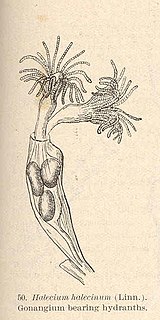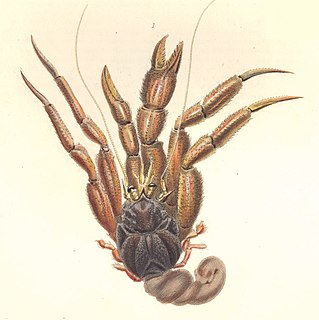
Hydrozoa are a taxonomic class of individually very small, predatory animals, some solitary and some colonial, most living in salt water. The colonies of the colonial species can be large, and in some cases the specialized individual animals cannot survive outside the colony. A few genera within this class live in fresh water. Hydrozoans are related to jellyfish and corals and belong to the phylum Cnidaria.

Hydractinia echinata is a colonial marine hydroid which is often found growing on dead, hermit-crabbed shells of marine gastropod species. This hydroid species is also commonly known as snail fur, a name which refers to the furry appearance that the hydroids give to a shell.

Hydractinia symbiolongicarpus is one of the 30 + Hydractinia species known worldwide. This saltwater animal, from here on referred to as Hydractinia, is at the base of the Cnidaria phylum and in many ways, is similar to the freshwater Hydra. In the wild, Hydractinia feed on smaller invertebrates found in the shallow mud, however in laboratory environments they are fed brine shrimp. Hydractinia symbiolongicurpus and its sibling species, Hydractinia echinata, are the two species from the genus Hydractinia on which most work has been published.

Nucella squamosa, common name the scaly dogwhelk, is a species of sea snail, a marine gastropod mollusk in the family Muricidae, the murex snails or rock snails.
Bougainvilliidae is a family of marine hydroids in the class Hydrozoa. Members of the family are found worldwide. There are sixteen accepted genera and about ninety-three species.

Hydractinia is a genus of commensal athecate hydroids which belong to the family Hydractiniidae. Hydractinia species mostly live on hermit-crabbed marine gastropod shells.

Eudendrium ramosum, sometimes known as the tree hydroid, is a marine species of cnidaria, a hydroid (Hydrozoa) in the family Eudendriidae of the order Anthoathecata.

Obelia longissima is a colonial species of hydrozoan in the order Leptomedusae. Its hydroid form grows as feathery stems resembling seaweed from a basal stolon. It is found in many temperate and cold seas world-wide but is absent from the tropics.

The tubular hydroid is a species of hydroid cnidarian, and is found in temperate coastal waters. It is a member of the family Tubulariidae.

The tubular sponge hydroid is a species of hydroid cnidarian. It is a member of the family Tubulariidae. These animals usually grow embedded in sponges.

Hydrocorella africana, the shell-mimic hydroid, is a small colonial encrusting hydroid in the family Hydractiniidae.

Corhiza scotiae, the fine hydroid, is a delicate colonial hydroid in the family Halopterididae.

Gattya humilis, the snowdrop hydroid, is a delicate colonial hydroid in the family Halopterididae.

Pycnotheca mirabilis, The feathery hydroid, is a colonial hydroid in the family Kirchenpaueriidae. Feathery hydroids are often white and grow in crowded colonies resembling upright feathers. The stems may grow to 3 cm in total height. The reproductive bodies are found at the base of the stems and resemble beehives.

Aglaophenia pluma, the toothed feather hydroid or podded hydroid, is a colonial hydroid in the family Aglaopheniidae and is found worldwide. It lives from the shore to 120m under water.

Macrorhynchia filamentosa, the smoky feather hydroid, is a colonial hydroid in the family Aglaopheniidae.

Halecium halecinum, commonly known as the herring-bone hydroid, is a species of hydrozoan in the family Haleciidae. It is native to the eastern Atlantic Ocean, the western Atlantic Ocean and the eastern Pacific Ocean.

Labidochirus splendescens, commonly known as the splendid hermit crab, is a species of hermit crab found in the northeastern Pacific Ocean off the coast of North America. It is more heavily calcified and inhabits smaller mollusc shells than most hermit crabs.
Schuchertinia milleri, commonly known as the Miller hydractinia, hedgehog hydroid or snail fur, is a small colonial hydroid in the family Hydractiniidae, found in the eastern Pacific Ocean. It forms mat-like colonies on rocks, or sometimes on the mollusc shells occupied by hermit crabs.
Janaria is a genus of commensal athecate hydroids in the family Hydractiniidae. It is a monotypic genus and the only species is Janaria mirabilis, commonly known as staghorn hydrocoral. It is a colonial species and lives on a shell occupied by a hermit crab. It is native to the tropical and semitropical eastern Pacific Ocean.


















